Quartz: It once held a great promise to the watch industry. This innovative new technology would make it possible to create wristwatches that could tell time with unbelievable accuracy. The technology to do so was decades in the making. Warren Marrison, a telecommunications engineer at Bell Laboratories, was in the late 1920s on a quest to discover more reliable frequency standards for radio transmissions. Working with Joseph W. Horton, he turned his attention to quartz crystals, a piezoelectric material. This means the crystals produce electric energy when mechanical stress is applied to them. It also works the other way around, so when you put an electric charge on a quartz crystal, mechanical stress appears as it starts to vibrate. The frequency of this vibration can be influenced based on the shape, thickness and lattice plane of which the quartz crystal is cut. When the electric charge is continuously applied, the frequency of the vibrations will be stable.
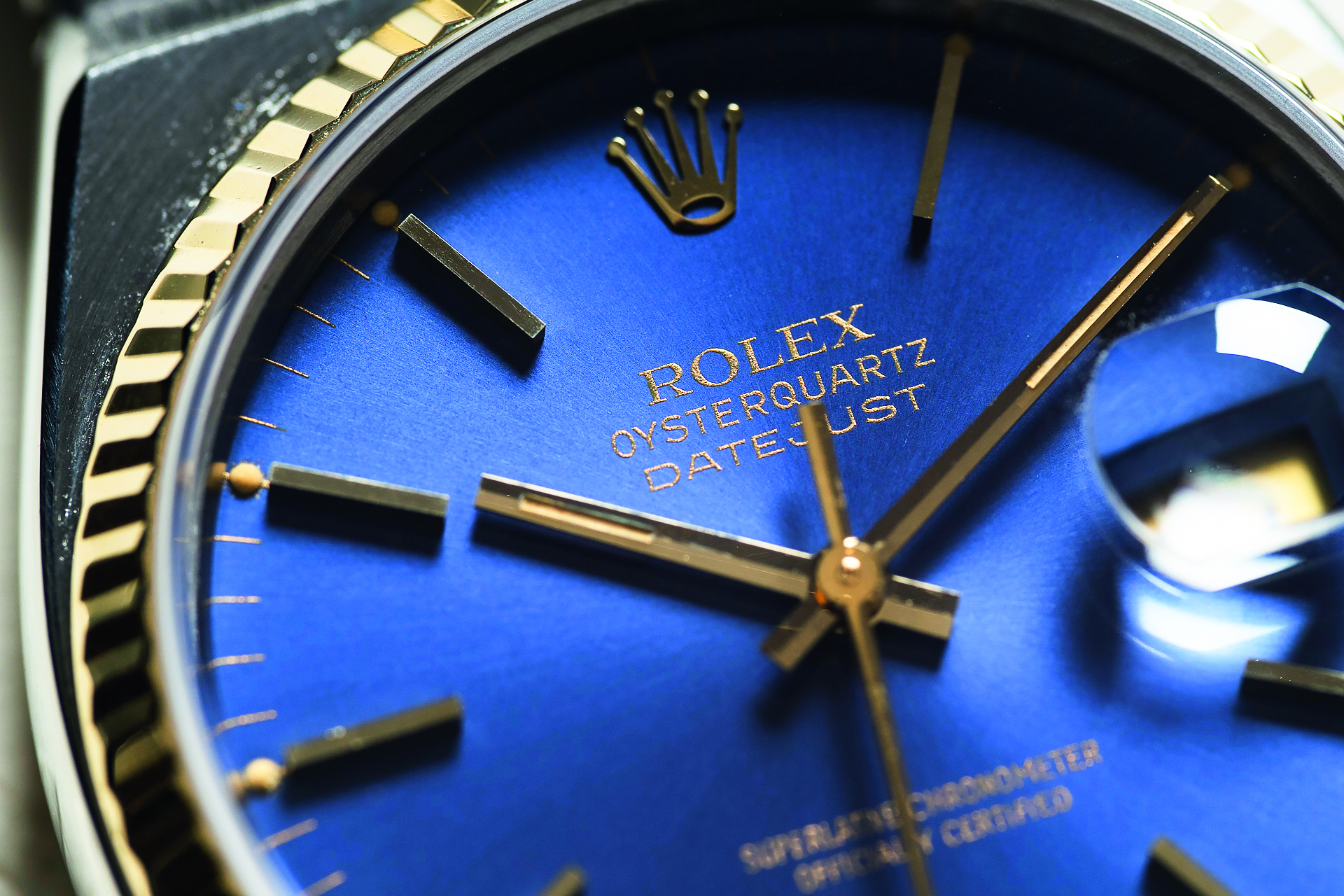 The dial of the desirable Rolex Oysterquartz Datejust Ref. 17013
The dial of the desirable Rolex Oysterquartz Datejust Ref. 17013When Marrison and Horton started their work, the concept of quartz crystals was known, but the frequency was too high to count. Driven by the idea of counting the number of vibrations in a specific period and, therefore, accurately determining the frequency, they succeeded in 1927 in dividing electronically the frequency enough so that it could drive a synchronous motor. While not their intention, they invented the first quartz clock, and when they realised this, they spent the next year perfecting their creation for this purpose.
The First Steps
The first quartz clocks were very bulky and initially only used in (time standard) laboratories, but as time passed, miniaturisation enabled them to be made smaller and smaller. By 1960, this development was progressed enough for it to be used in marine chronometers. During this time, increased precision and alternative technologies were a hot topic at the head- quarters of multiple watch brands around the world. Electric wristwatches, which had a battery as a power source combined with a balance wheel, were already around since the 1950s. More recently, Bulova enjoyed great success with its Accutron, based on the vibrations of a tuning fork, which it launched in 1960.
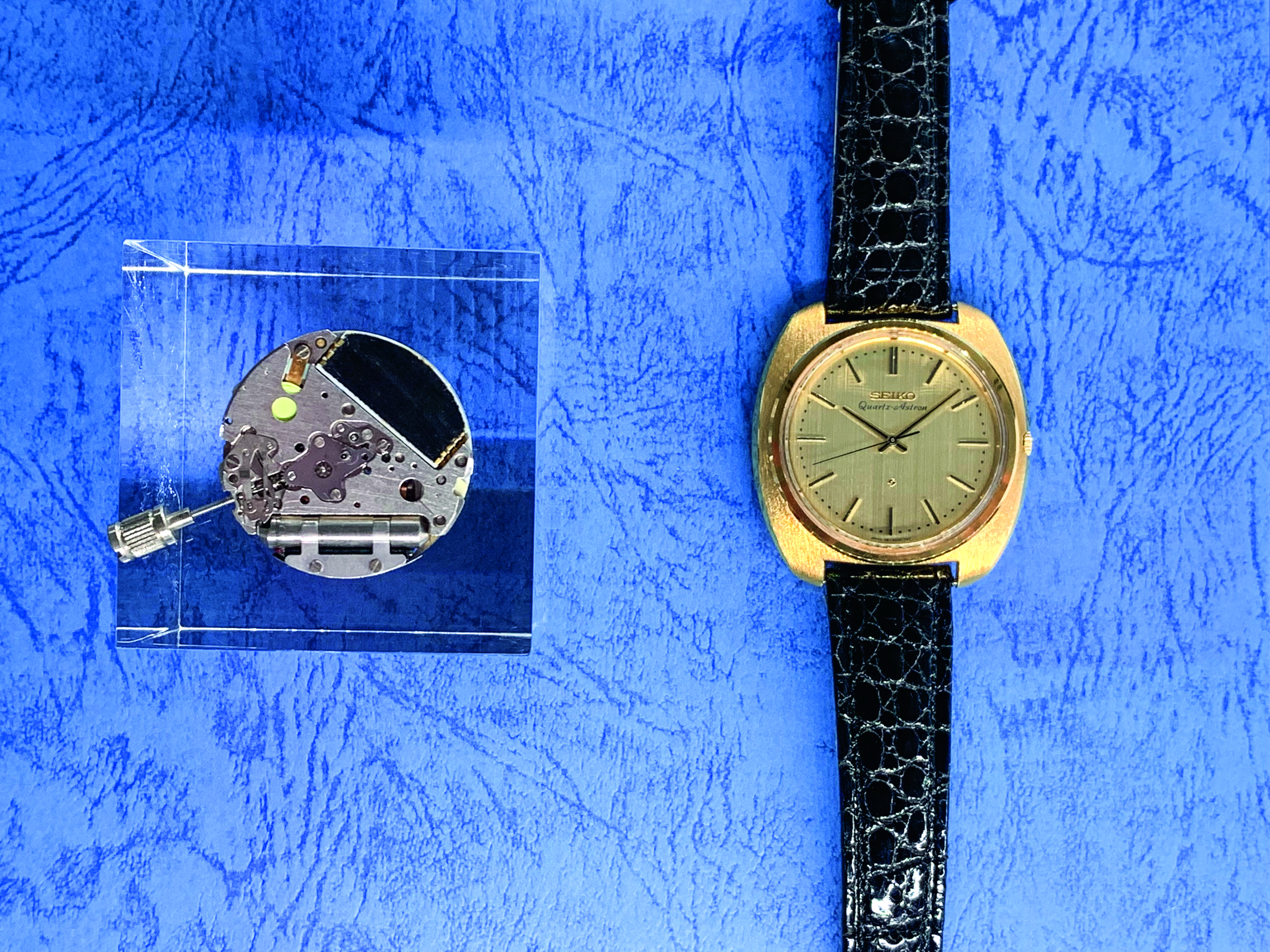 The Seiko Quartz Astron 35SQ
The Seiko Quartz Astron 35SQ
Other brands felt a need to also venture into new technologies to power their watches. A few set out on their own, but others decided to join forces. Some of the most reputable names in the Swiss watch industry, including Rolex, Omega, Patek Philippe and Piaget, founded the Centre Electronique Horloger (CEH) in 1962. After exploring different technologies, before focusing on quartz, CEH gave a taste of the future by entering 11 of its prototypes into the prestigious “Concours Chronométrique International de l’Observatoire de Neuchâtel” in 1967. This contest was meant as a challenge for the entire industry to improve the quality and precision of their products. The quartz wristwatches impressed with their accuracy, which outperformed that of already commercialised battery-powered wristwatches like the Bulova Accutron.
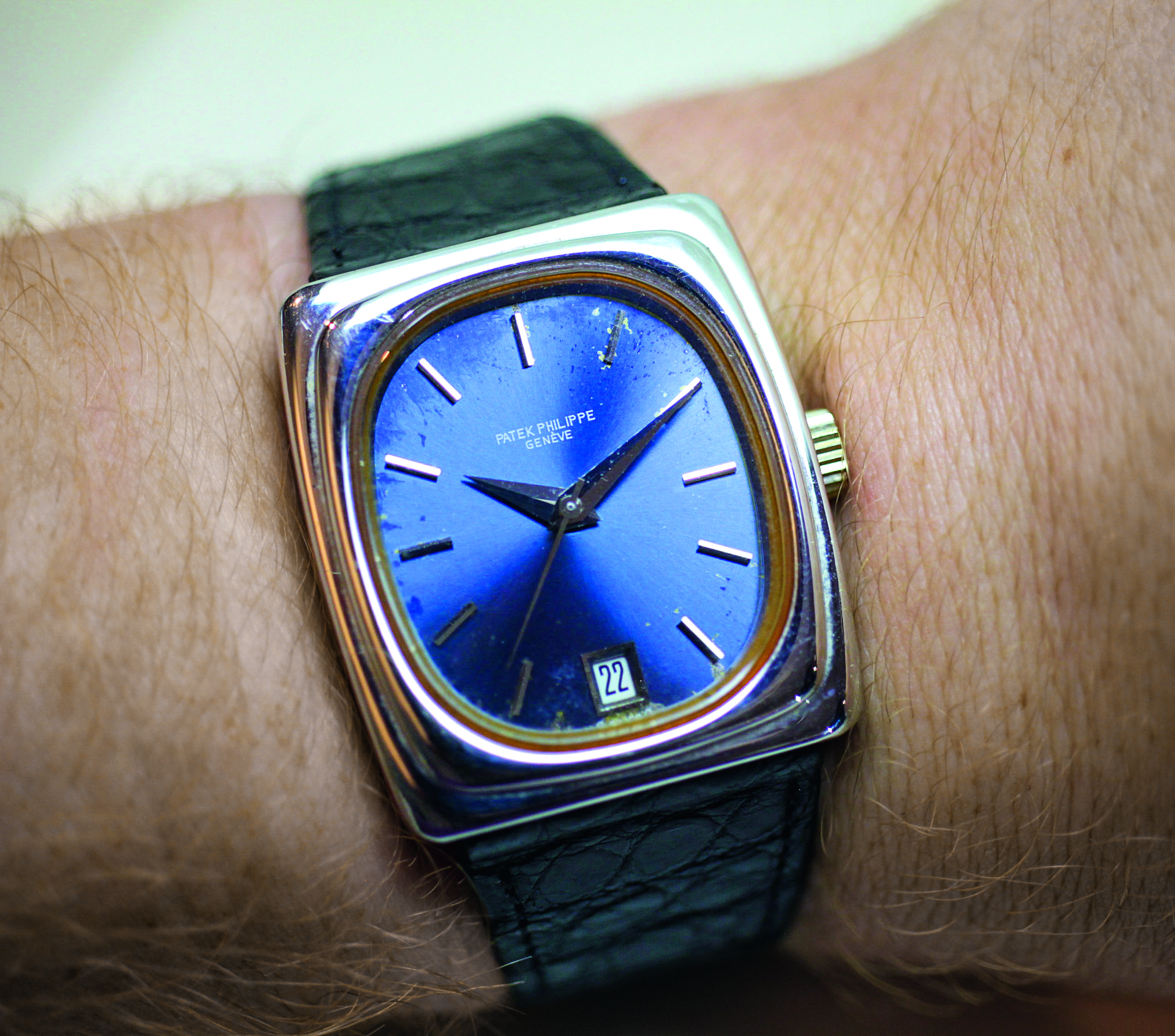 Vintage Patek Philippe with Beta 21
Vintage Patek Philippe with Beta 21The CEH wasn’t the only one participating in this category, as Suwa Seikosha (currently Seiko Epson Corporation) was also competing fiercely. While they couldn’t quite yet deliver the same precision as the CEH prototypes, they weren’t far off. The Japanese had already proved themselves to be fast learners. When they first entered the competition, which also had categories for mechanical wrist and pocket watches as well as Marine Chronometers, in 1964, their timepieces scored too low even to pass the test, but a mere three years later, they were a top-10 contender. In fact, at the same 1967 edition of the “Concours Chronométrique International de l’Observatoire de Neuchâtel,” Suwa Seikosha secured the top five places in the Pocket Chronometer category.
A Precious Beginning
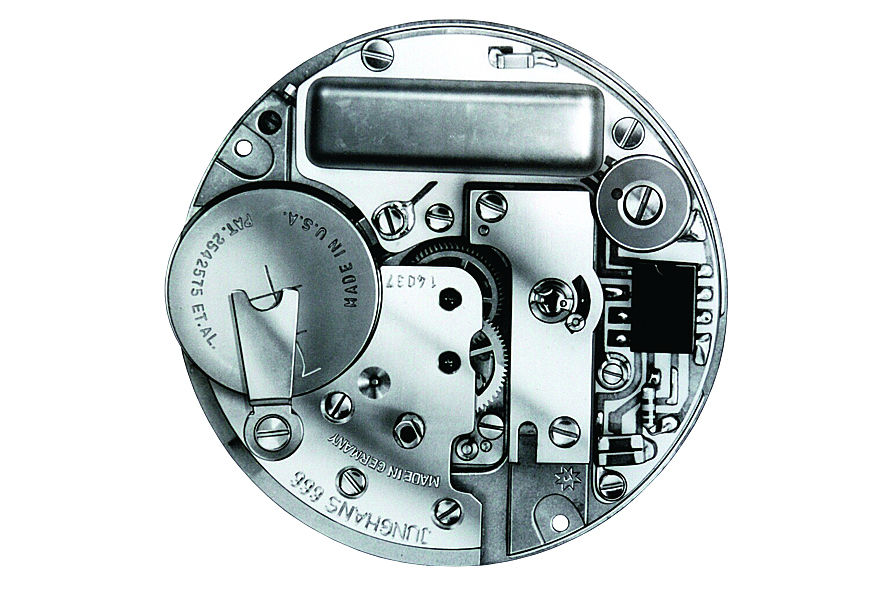 Junghans' first quartz calibre W666
Junghans' first quartz calibre W666On Dec. 25, 1969, Seiko officially launched the Quartz Astron 35SQ, the world’s first commercially available quartz wristwatch. For its price of 450,000 yen, you could buy a nice new car at the time, but instead, you were one of the 100 people who got to wear groundbreaking technology in a gold-cased watch that represents a landmark moment in watchmaking history. The Swiss weren’t far behind, but not all brands participating in the CEH decided to launch a watch powered by the Beta-21, the quartz calibre that reached production state.
 Model presenting Junghans' first quartz watch
Model presenting Junghans' first quartz watchWhile its accuracy was impressive, the Swiss brands struggled with the relatively large, rectangular movement. Patek Philippe and Piaget used to work with ultra-slim mechanical movements and had their designers challenged to come up with designs that maintained (some of) their usual elegance. Rolex even launched its watch with the Beta-21 movement, the Reference 5100, without its signature Oyster case, but with a sapphire crystal, a first for the brand. Like Seiko, the prices of the first Swiss quartz watches were steep. The gold case can partly explain this, but mainly because of the revolutionary technology.
Meanwhile, in Germany ...
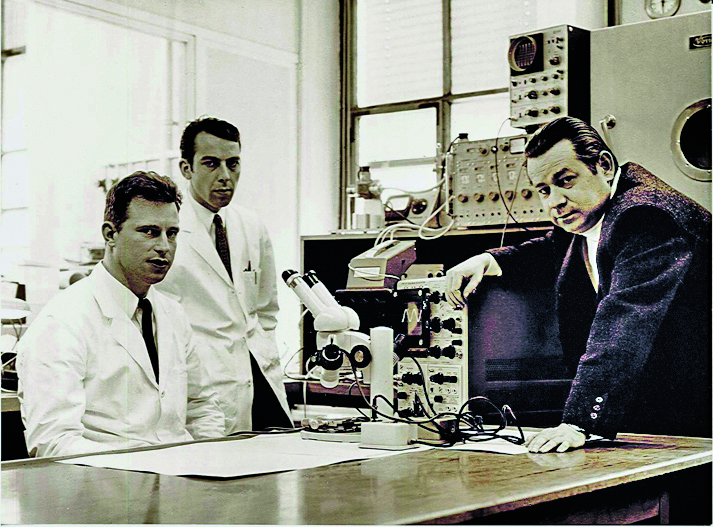 The development team at Junghans at the end of the 1960's under supervision by Dr.-Ing. Friedrich Assums (far right)
The development team at Junghans at the end of the 1960's under supervision by Dr.-Ing. Friedrich Assums (far right)The battle to launch the first quartz watch wasn’t only between Japan and Switzerland, as they were also making strides in Germany. Junghans, PUW, Para and Bifora joined forces and developed their own quartz movement. The team, led by Dr.-Ing. Friedrich Assmus, started in 1967 and used Caliber W610, which was used to power clocks as a basis. After working on it for four years, on April 14, 1971, they proudly introduced Caliber W666 in Frankfurt, Germany, which Junghans marketed as the Astro-Quartz.
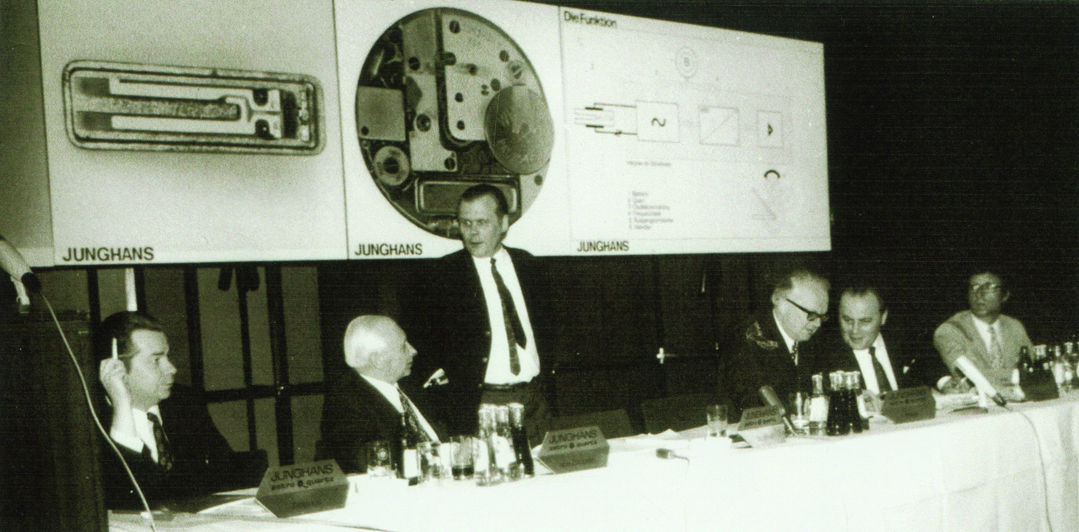 Dr.-Ing. Friedrich Assums presents the Junghans Astro-Quartz to the press on April 14,1971, in Frankfurt, Germany
Dr.-Ing. Friedrich Assums presents the Junghans Astro-Quartz to the press on April 14,1971, in Frankfurt, GermanyInitially, they used a quartz crystal shaped like a tuning fork but quickly changed to less expensive bar-shaped quartz crystals for series production. After a collaboration with Siemens, which would supply the integrated circuit, didn’t work out, Motorola, which also collaborated with Girard-Perregaux, would take over. This flexibility and focus on continuous development would make Caliber W666 and its successor, Caliber W667, a great success, as a total of 1 million movements were produced. They would lay the foundation for Junghans to become a dominant force in quartz watches, a position they further secured by continuous development, launching later on even radio-controlled quartz watches and movements that got their energy from solar power. Today, about 50 percent of its collection is still powered by one of these advanced quartz movements.
Democratising the Precise
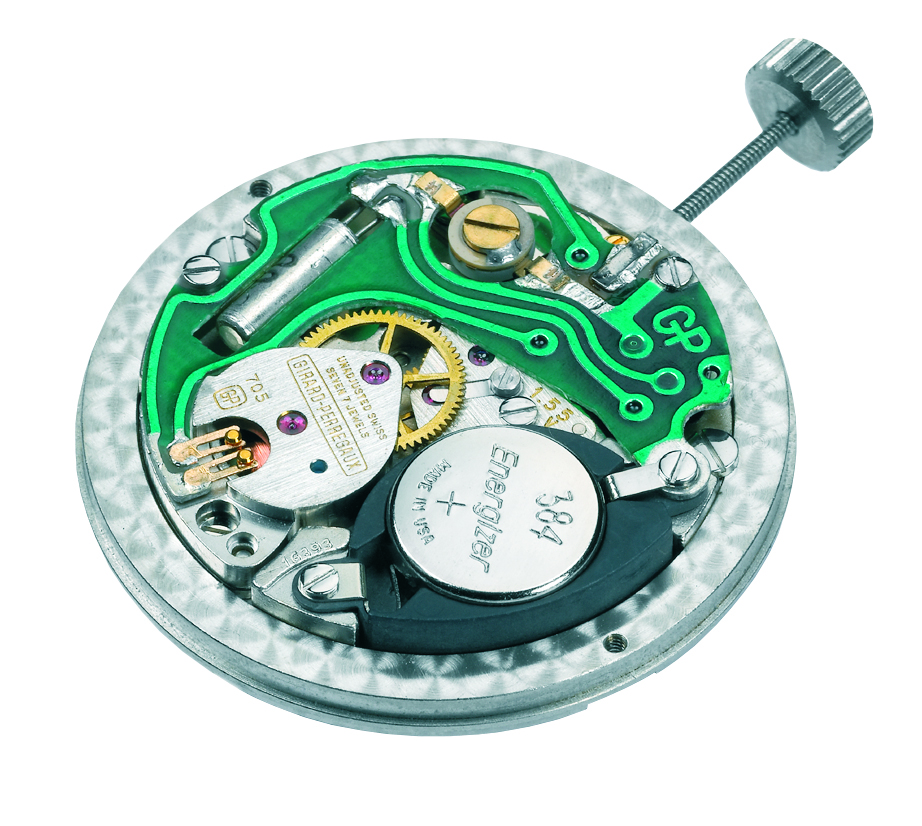 Girard-Perregaux has taken quartz seriously since the beginnings and continued to develop its quartz movements
Girard-Perregaux has taken quartz seriously since the beginnings and continued to develop its quartz movementsIn the early 1970s, quartz watches were the supercars of the industry. With their superb precision, there was a unique selling point to validate the higher price. For the Swiss brands, quartz perfectly complemented their mechanical offerings, but they had another vision for quartz on the other side of the world. The Seiko Quartz Astron 35SQ was a groundbreaking watch, and not only because it was the first.
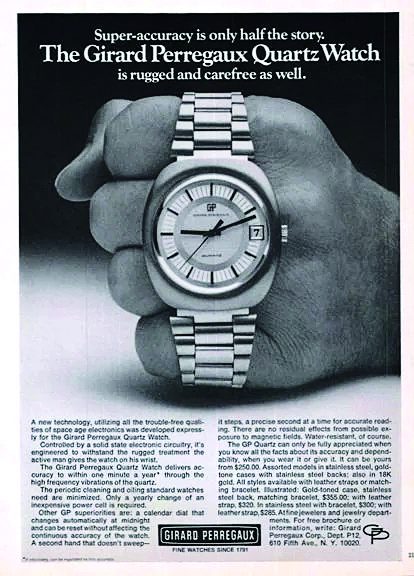 Vintage ad of Girard-Perregaux's first quartz watch
Vintage ad of Girard-Perregaux's first quartz watchIt was surprisingly thin and fitted with a tuning-fork type quartz oscillator that was shock-resistant and low in power consumption. As with the Neuchâtel precision competitions, the Japanese showed an incredibly steep learning curve and achieved the impossible; they started mass-producing quartz movements, offering high precision in far more affordable watches. In Germany, Junghans went in a similar direction. This marked the beginning of what is commonly known as the “Quartz Crisis,” which nearly whipped out Swiss watchmaking before another quartz watch, known as Swatch, played an essential role in getting it back on its feet again.
Collecting Vintage Quartz Watches
 First generation of Girard-Perregaux Laureato with quartz movement and diamond-set bezel
First generation of Girard-Perregaux Laureato with quartz movement and diamond-set bezelThe answer to whether vintage quartz watches are collectible is a definitive yes, not only for their role in watchmaking history but also for their technology. Seeing one of those early quartz movements makes you realise not only what a big step it was from the traditional mechanical calibres but also how they have progressed when you compare them to modern-day quartz movements. To start with the downside, keeping them up and running can be challenging, as in most cases, replacement parts are not available anymore. The good news is that many of them have proven to withstand the test of time and are still in running condition.
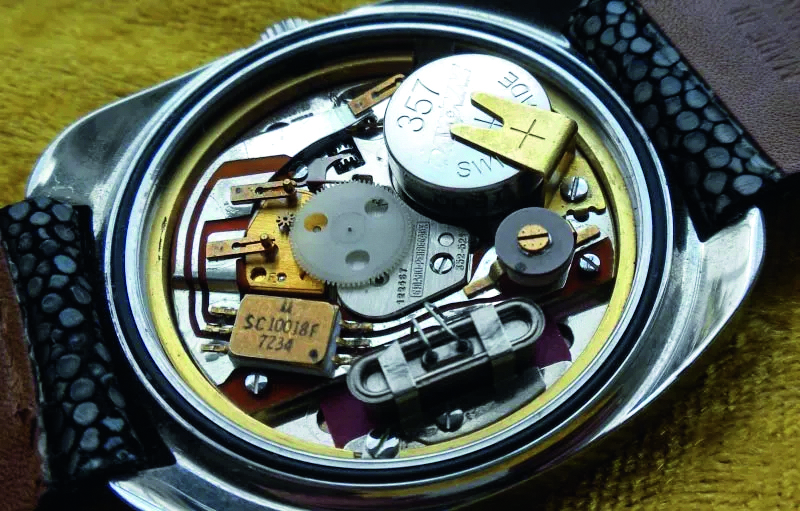 Inside Girard-Perregaux's quartz watch. Note the Motorola logo on the integrated circuit.
Inside Girard-Perregaux's quartz watch. Note the Motorola logo on the integrated circuit.While pointing out all the vintage quartz watches that could be of interest could easily fill this entire issue, two are of particular interest given their history. One of them is Girard- Perregaux’s first quartz watch. The brand didn’t join the CEH but made a bold move to develop the technology itself. To achieve this, they got Georges Vuffray, an electronics expert who previously had developed a quartz clock, on board and partnered with Motorola, who would make the integrated circuit for the movement.
 Girard-Perregaux's first quartz watch
Girard-Perregaux's first quartz watchWhile Girard-Perregaux didn’t beat Seiko in being the first, they did establish what would become the standard frequency of quartz watches at 32,768 Hz. It is quite challenging to compare the Beta-21 against the Girard-Perregaux calibre today, but while many brands abandoned the first, others embraced the latter. It was a rare occasion that Jaeger-LeCoultre sourced a movement from another brand, as it was usually the other way around. Their MasterQuartz collection was powered by the Girard-Perregaux calibre, making them both interesting to collect.
Quartz with a Crown
 The Rolex Oysterquartz Datejust Ref. 17013 on the wrist
The Rolex Oysterquartz Datejust Ref. 17013 on the wristWhile Rolex did use the Beta-21 in their Reference 5100, they ultimately decided to create their own quartz movement. The development took five years, and in 1977, Rolex launched the Oyster-quartz. At the time, it was quite a futuristic model for the brand, although trend-wise in line with the popular Gérald Genta designs of that era. The integrated bracelets were modern interpretations of the classic Oyster, Jubilee and President bracelet, and in particular, the first two rank as some of the sturdiest bracelets Rolex has ever made. The Oysterquartz was an entire collection consisting of Datejust and Day-Date models in different varieties. Like the Reference 5100, they were also equipped with a sapphire crystal, years before the mechanical Rolex models would follow suit.
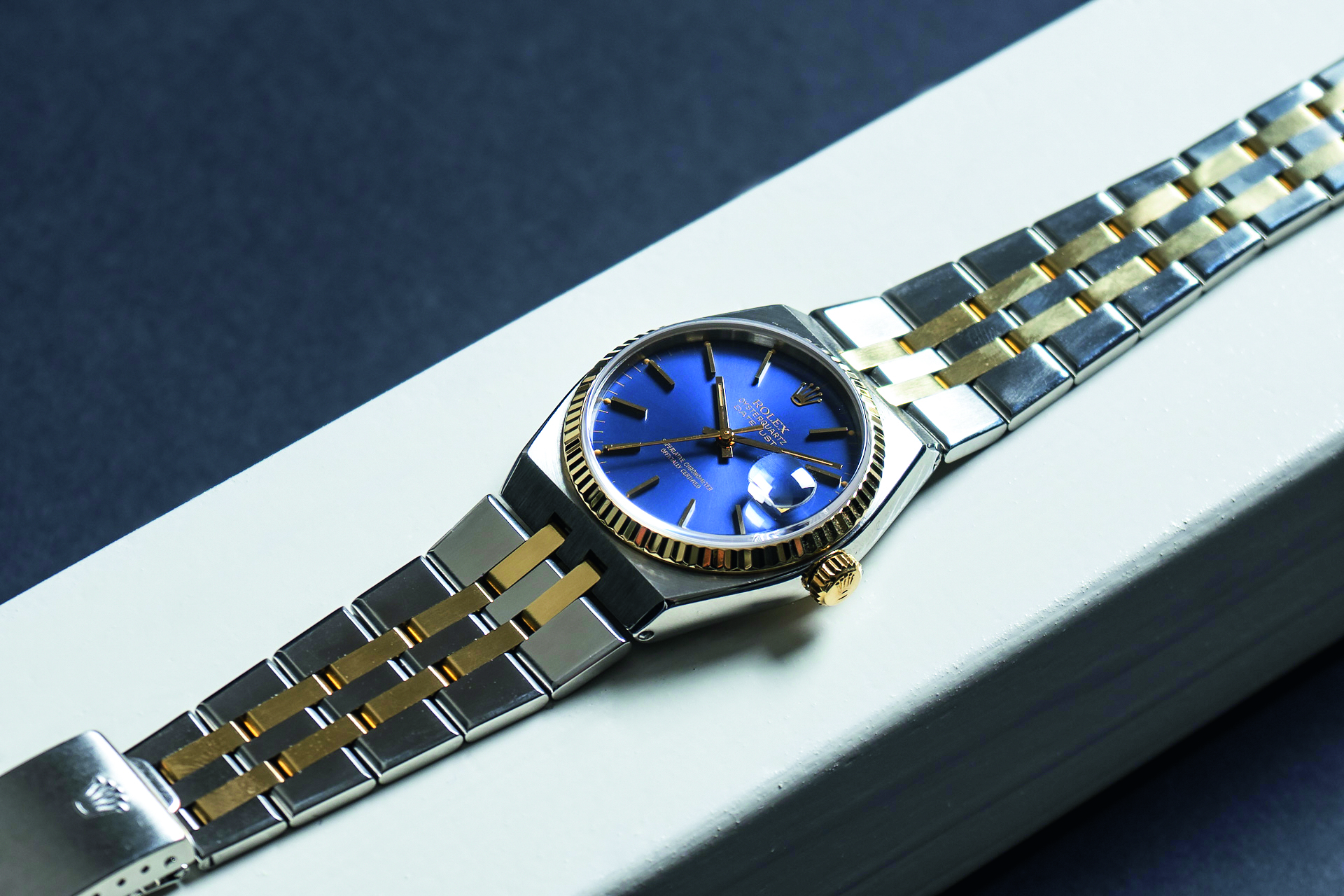 Rolex also redisigned its famous Jubilee bracelet for the Oysterquartz
Rolex also redisigned its famous Jubilee bracelet for the OysterquartzThe quartz Calibre 5035 (Datejust) and 5055 (Day-Date) are typical Rolex movements. One could say that they are overengineered, with a focus on performance and being easy to service. They feature a pulse motor that drives a pallet fork, which turns the pallet wheel. All the parts traditionally also found in mechanical calibres are identical to those used in calibre 3035, the automatic movement which Rolex also introduced in 1977. The finishing of the quartz calibres is also on par, or even above, with its mechanical counterparts at the time, with perlage, anglage, and Geneva stripes.
While a superb product, inexpensive quartz movements were at the time also embraced by counterfeiters, which flooded the market with fake Rolex. A common way for the public to tell the difference between a real one and a fake was to see if the seconds hand ran smoothly or ticked from second to second. This was not in favour of the Oysterquartz. It is said that Rolex made a total of 25,000 watches of all the Oysterquartz models combined, and they remained in the Rolex catalogs for well over two decades. This makes them not only a very interesting quartz watch but also a rare piece of Rolex history.
Images Courtesy: www.watchworksshaarlem.com, Martin Green, Logan and Baker.




























